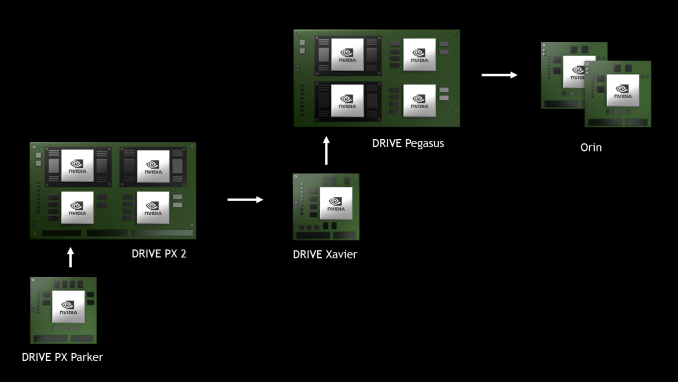NVIDIA ARM SoC Roadmap Updated: After Xavier Comes Orin
by Ryan Smith on March 29, 2018 11:00 AM EST
As part of this week’s GTC 2018 keynote address, NVIDIA CEO Jen-Hsun Huang quickly touched upon the future of NVIDIA’s ARM SoC lineup. While the company no longer publicly advertises or sells new ARM-based SoCs – the last SoC branded Tegra was the Tegra X1 – they have continued development for private uses. Chief among these of course being their DRIVE systems, where the Xavier SoC is at the heart of both the single-SoC Xavier module, as well as the larger and more powerful muti-processor Pegasus module for level 5 vehicles.
While Xavier itself is just now sampling to partners, NVIDIA already has their eye on what’s next. And that is Orin.
Unlike even the Xavier tease in 2016, NVIDIA is saying very little about Orin other than the fact that it’s the next generation of NVIDIA SoCs. Like Xavier, it’s a single-chip solution. But otherwise we don’t know anything about the planned architecture or features.
| NVIDIA ARM SoC Specification Comparison | |||||
| Orin | Xavier | Parker | |||
| CPU Cores | ? | 8x NVIDIA Custom ARM "Carmel" | 2x NVIDIA Denver + 4x ARM Cortex-A57 |
||
| GPU Cores | ? | Xavier Volta iGPU (512 CUDA Cores) |
Parker Pascal iGPU (256 CUDA Cores) |
||
| DL TOPS | [A Ton] | 30 TOPS | N/A | ||
| FP32 TFLOPS | ? | 1.3 TFLOPs | 0.7 TFLOPs | ||
| Manufacturing Process | 7nm? | TSMC 12nm FFN | TSMC 16nm FinFET | ||
| TDP | ? | 30W | 15W | ||
With respect to performance, NVIDIA isn’t giving hard figures there either, but they are saying that they want to replace a Pegasus module with a couple of Orins. Pegasus, as a reminder, is a pair of Xaviers each with an unnamed, post-Volta discrete GPU attached, with a total power consumption of 500W. So to replace that with a couple of single-chip SoCs would be a significant accomplishment – and presumably a massive bump in energy efficiency.
But finally, let’s talk about the real question on everyone’s mind: which superhero is this new SoC named after? After a run in the Marvel universe, it looks like NVIDIA is back to favoring DC. A brief search shows that Orin is another name for Aquaman. Which certainly isn’t as high-profile as the likes of Kal-El, Wayne, or Xavier, but perhaps Jen-Hsun Huang is a big fan of Jason Momoa? (ed: and indeed, who doesn’t find Aquaman outrageous?)










43 Comments
View All Comments
mode_13h - Saturday, April 7, 2018 - link
No. Orin only beats it in Tensor FLOPS.epobirs - Monday, April 9, 2018 - link
It's extremely unlikely Sony or Microsoft will move away from x86-64 architecture for their next generation. Such changes in the past happened when there was a lack of a good upgrade path.Microsoft had an untenable situation with the way the original Xbox hardware was sourced, PowerPC had become a dead-end by the time a 360 successor needed to get underway.
Over at Sony, the PS3 had the dual problems of PowerPC and the CELL use of it, which never delivered on the absurd claims Sony, Toshiba, and IBM made for it back when it was first announced. The process of getting from the original plan to what became the PS3 design (Nvidia's GPU was added very late in the game, so much so that no actual PS3 existed for its E3 premiere, so all the demos were either CELL or Nvidia on PC) was more than a little painful and expensive.
I'd be very surprised if the partnership with AMD didn't continue. They have a strong upgrade path to offer in the combination of Ryzen and Vega. The recently announced APU products are very likely the early basis of what the console makers will request from AMD. There will likely be some customization to mitigate compatibility issues, among other things. At least 8/16 cores/threads, at least 16GB RAM, etc. A pretty natural progression that is a substantial jump from their current high end models.
Another question is whether the PS4 Pro and Xbox One X can see enough cost reduction to keep them going for a while as the low end models.
mode_13h - Monday, April 9, 2018 - link
I feel like Cell eventually delivered, though it was a steep learning curve and depended much on 2nd and 3rd party libraries optimized for it. The difference between early and late PS3 games is night and day.The raw compute power of Cell was just monstrous, at the PS3's launch. Sure, it came at the expense of programmability, but it truly leapfrogged anything in the PC world, at the time. The console world hasn't seen anything like it, since. And probably never will.